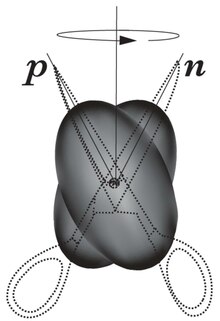Scissors Modes are collective excitations in which two particle systems move with respect to each other conserving their shape. For the first time they were predicted to occur in deformed atomic nuclei by N. LoIudice and F. Palumbo, who used a semiclassical Two Rotor Model, whose solution required a realization of the O(4) algebra that was not known in mathematics. In this model protons and neutrons were assumed to form two interacting rotors to be identified with the blades of scissors. Their relative motion (Fig.1) generates a magnetic dipole moment whose coupling with the electromagnetic field provides the signature of the mode.

Such states have been experimentally observed for the first time by A. Richter and collaborators in a rare earth nucleus, Gd, and then systematically investigated experimentally and theoretically in all deformed atomic nuclei.
Inspired by this, D. Guéry-Odelin and S. Stringari predicted similar collective excitations in Bose-Einstein condensates in magnetic traps. In this case one of the blades of the scissors must be identified with the moving cloud of atoms and the other one with the trap. Also this excitation mode was experimentally confirmed.
In close analogy similar collective excitations have predicted in a number of other systems, including metal clusters, quantum dots, Fermi condensates and crystals, but none of them has yet been experimentally investigated or found.
References
- Iudice, N. Lo; Palumbo, F. (1978). "New Isovector Collective Modes in Deformed Nuclei". Physical Review Letters. 41 (22). American Physical Society (APS): 1532–1534. Bibcode:1978PhRvL..41.1532I. doi:10.1103/PhysRevLett.41.1532. ISSN 0031-9007.
- Bohle, D.; Richter, A.; Steffen, W.; Dieperink, A. E. L.; Iudice, N. Lo; Palumbo, F.; Scholten, O. (1984). "New magnetic dipole excitation mode studied in the heavy deformed nucleus 156Gd by inelastic electron scattering". Physics Letters B. 137 (1–2). Elsevier BV: 27–31. Bibcode:1984PhLB..137...27B. doi:10.1016/0370-2693(84)91099-2. hdl:11370/bd9c55b2-eebb-4ece-a096-577997e50e15. ISSN 0370-2693. S2CID 120408708.
- Guéry-Odelin, D.; Stringari, S. (1999). "Scissors Mode and Superfluidity of a Trapped Bose-Einstein Condensed Gas". Physical Review Letters. 83 (22). American Physical Society (APS): 4452–4455. arXiv:cond-mat/9907293. Bibcode:1999PhRvL..83.4452G. doi:10.1103/PhysRevLett.83.4452. ISSN 0031-9007. S2CID 119465641.
- Maragò, O. M.; Hopkins, S. A.; Arlt, J.; Hodby, E.; Hechenblaikner, G.; Foot, C. J. (2000). "Observation of the Scissors Mode and Evidence for Superfluidity of a Trapped Bose-Einstein Condensed Gas". Physical Review Letters. 84 (10). American Physical Society (APS): 2056–2059. arXiv:cond-mat/9911195. Bibcode:2000PhRvL..84.2056M. doi:10.1103/PhysRevLett.84.2056. ISSN 0031-9007. PMID 11017208. S2CID 22897316.
- Lipparini, E.; Stringari, S. (31 July 1989). "Rotational magnetic state in deformed metal clusters". Physical Review Letters. 63 (5). American Physical Society (APS): 570–572. doi:10.1103/physrevlett.63.570. ISSN 0031-9007. PMID 10041109.
- Serra, Llorenç; Puente, Antonio; Lipparini, Enrico (15 November 1999). "Orbital current mode in elliptical quantum dots". Physical Review B. 60 (20). American Physical Society (APS): R13966 – R13969. arXiv:cond-mat/9909135. doi:10.1103/physrevb.60.r13966. ISSN 0163-1829. S2CID 15101298.
- Minguzzi, Anna; Tosi, Mario P. (16 January 2001). "Scissors mode in a superfluid Fermi gas". Physical Review A. 63 (2): 023609. arXiv:cond-mat/0005098. doi:10.1103/physreva.63.023609. ISSN 1050-2947. S2CID 119079410.
- Hatada, Keisuke; Hayakawa, Kuniko; Palumbo, Fabrizio (21 March 2005). "Scissors mode and dichroism in an anisotropic crystal". Physical Review B. 71 (9). American Physical Society (APS): 092402. arXiv:cond-mat/0402193. doi:10.1103/physrevb.71.092402. ISSN 1098-0121. S2CID 119331352.